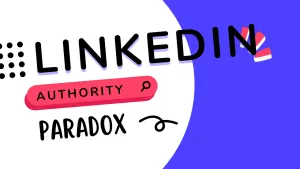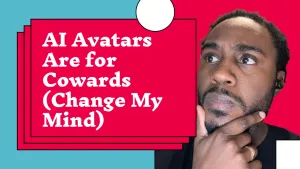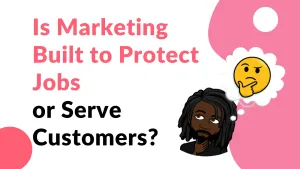There's a massive disconnect happening on LinkedIn right now, and it's costing professionals serious opportunities.
On one side, you've got LinkedIn crushing every other social platform with a 6.50% average engagement rate, absolutely demolishing Facebook (5.07%), TikTok (4.86%), and Instagram (1.16%).
On the other side, you've got professionals posting like they're at a casual networking happy hour instead of building genuine authority in front of 1.2 billion members.
The result? The platform with the highest engagement and the most B2B decision-makers is being used by professionals who are afraid to actually demonstrate their professional expertise.
It's like having access to the world's largest professional conference that never ends, and using it to share breakfast photos and motivational quotes.

The LinkedIn Authority Paradox: Why Everyone's Getting It Wrong
Here's what's driving this paradox: LinkedIn has become the most engaging social platform on the planet, yet most professionals are using it in ways that actually hurt their authority instead of building it.

The numbers tell an incredible story.
LinkedIn's Engagement Dominance:
- LinkedIn: 6.50% engagement rate
- Facebook: 5.07% engagement rate
- TikTok: 4.86% engagement rate
- Instagram: 1.16% engagement rate
But here's the kicker: while LinkedIn's engagement jumped from 6.00% in January 2024 to 8.01% in January 2025, most professionals are still posting content that could appear on any social platform.
Meanwhile, the data is screaming at us about what actually works:
- 89% of B2B marketers use LinkedIn for lead generation
- 40% of B2B marketers rate LinkedIn as the most effective channel for driving high-quality leads
- 97% of B2B marketers use LinkedIn for content marketing
- 33% of B2B decision-makers use LinkedIn to research purchases
- 50% of business users use LinkedIn to make purchase decisions
Notice what's missing from that list? Generic motivational content and personal life updates.
The Facebook Syndrome: Why Professionals Are Scared to Be Professional
Most professionals suffer from what we call the "Facebook Syndrome", this weird belief that professional content has to be boring, corporate, or overly formal.
So instead of sharing their expertise, they default to:
- Motivational quotes over stock photos
- Generic "lessons learned" posts that could apply to anyone
- Random personal updates that have nothing to do with their field
- Vague "thoughts on leadership" without specific insights
This approach isn't just ineffective, it's counterproductive. When you post generic content, you're training the algorithm (and your audience) that you don't have anything valuable to say about your actual area of expertise.
The professionals who are winning on LinkedIn understand something crucial: LinkedIn rewards expertise, not personality alone.
The Authority Building Opportunity (That Most People Are Missing)
LinkedIn is literally handing professionals the biggest authority-building opportunity in business history, and most are walking right past it.
Consider the scale:
- 1.2 billion members globally
- 1.77 billion monthly visits
- A quarter of users interact with brand content daily
- 81% of B2B buyers share business-related content with their LinkedIn network
This isn't just a social media platform, it's the world's largest professional conference that never ends. Unlike expensive industry events where you might meet 50 people over three days, LinkedIn gives you access to every decision-maker in your industry, every single day.
But here's the catch: they're not looking for your thoughts on work-life balance or your weekend updates. They're looking for insights, expertise, and solutions to their actual business problems.
The professionals who understand this are building incredible authority, consultants becoming industry thought leaders in 18 months, executives becoming the go-to experts in their field, and business owners turning their LinkedIn presence into their most effective sales channel.
The 3-Step Fix: How to Actually Build Authority on LinkedIn
After analyzing hundreds of successful LinkedIn authority builders, here's a simple 3-step framework that works consistently.
Step 1: The Expertise Audit (Stop Being Everything to Everyone)
The first mistake most professionals make is trying to be interesting to everyone. They post about leadership, productivity, industry trends, personal development, and whatever else they think might get engagement.
This approach is backwards.
The most successful LinkedIn users pick 2-3 specific areas of expertise and become known for those topics. That's it.
The Expertise Audit Process:
Ask yourself these three questions:
- What do people come to me for advice about?
- What problems do I solve better than most people?
- What topics could I talk about for hours without preparation?
The intersection of these three answers is your LinkedIn sweet spot.
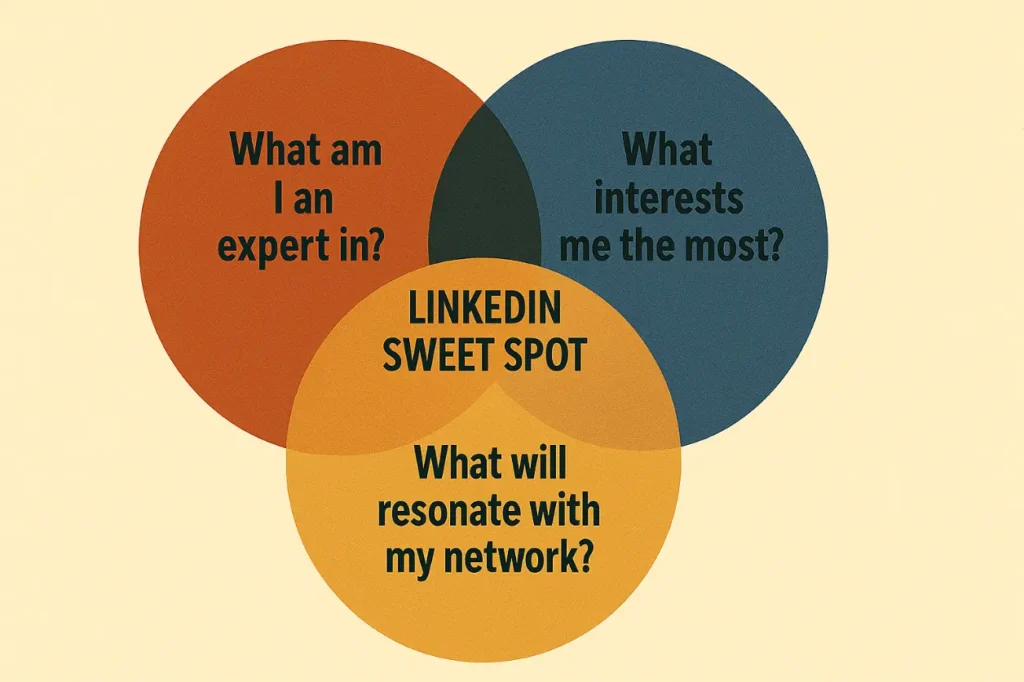
Instead of posting about "leadership lessons," get specific: "How to run effective remote team meetings when half your team is in different time zones." Instead of "productivity tips," try "The project management mistake that's costing your agency 15 hours per week."
The more specific you get, the more valuable you become to the right people.
Reality Check: Look at your last 20 LinkedIn posts. How many of them demonstrate specific expertise that only you could share? If the answer is less than 15, you've found your problem.
Step 2: The Video-First Authority Strategy (Because the Algorithm Loves It)
Here's a stat that should change how you think about LinkedIn content: users are creating 2x more videos than other content formats, and video gets the most shares on the platform.
But LinkedIn video isn't about production value, it's about expertise demonstration.
The most effective LinkedIn videos aren't polished marketing pieces. They're professionals sharing insights, walking through problems, or explaining concepts in their area of expertise.
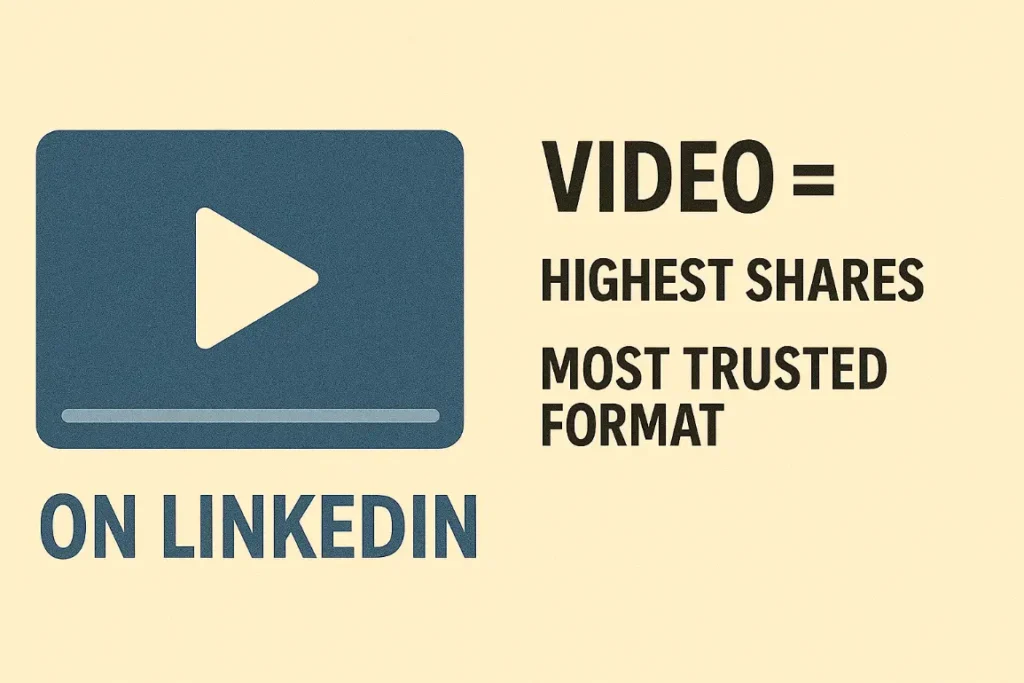
The Video-First Authority Framework:
Week 1: Share a specific insight or lesson learned
- "Here's what I learned from analyzing 50 failed product launches..."
- "The biggest mistake I see companies make with their pricing strategy..."
Week 2: Answer a common question in your field
- "Someone asked me about X, so here's my take..."
- "I keep getting asked about Y, so let me break it down..."
Week 3: Break down a current industry trend or news
- "Everyone's talking about Z, but here's what they're missing..."
- "Here's what this new regulation actually means for your business..."
Week 4: Share a behind-the-scenes look at your process
- "Here's how I approach [specific challenge]..."
- "Walk through my framework for [specific outcome]..."
The key is consistency and specificity. You're not trying to go viral, you're trying to build a reputation as someone who consistently shares valuable insights in your field.
Resource Alert: These YouTube tutorials break down successful LinkedIn video approaches:
Step 3: The Conversation Catalyst (Turn Engagement Into Authority)
Most professionals post content and then disappear. They treat LinkedIn like a broadcasting platform instead of a conversation platform.
The real authority building happens in the comments, the DMs, and the follow-up conversations that your content sparks.

The Conversation Catalyst Strategy:
Before you post: End every piece of content with a specific question that invites expertise sharing, not just opinions.
Instead of: "What do you think?" Try: "What's been your experience with [specific situation]?"
Instead of: "Agree or disagree?" Try: "How have you handled [specific challenge] in your organization?"
After you post: Spend 30 minutes engaging with every comment. Not just liking them, actually responding with follow-up questions or additional insights.
The follow-up: When someone shares a particularly insightful comment, send them a DM: "Really appreciated your perspective on [topic]. I'd love to hear more about [specific aspect they mentioned]."
This approach signals to the algorithm that your content is generating meaningful engagement (which means more reach), and positions you as someone who's genuinely interested in learning from others, not just broadcasting opinions.
The LinkedIn Content Performance Matrix: What Actually Works
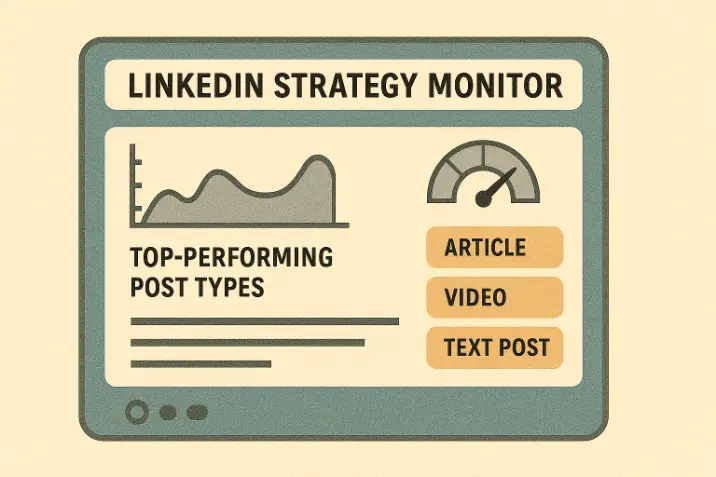
After analyzing thousands of successful LinkedIn posts, here's what actually drives engagement and authority building:
| Content Type | Engagement Rate | Authority Building Score | Best Use Case |
|---|---|---|---|
| Industry Insights | 8.2% | High | Establishing expertise |
| Behind-the-Scenes Process | 7.8% | High | Demonstrating competence |
| Trend Analysis | 7.1% | Medium-High | Thought leadership |
| Case Study Breakdowns | 6.9% | High | Proving results |
| Q&A/Problem Solving | 6.5% | High | Building trust |
| Professional Stories | 5.8% | Medium | Humanizing expertise |
| Industry News Commentary | 5.2% | Medium | Staying relevant |
| Motivational Content | 4.1% | Low | General engagement |
| Personal Life Updates | 2.8% | Very Low | Personal branding |
Note: Authority Building Score based on correlation with business inquiries and speaking opportunities
The pattern is clear: content that demonstrates specific expertise consistently outperforms generic content, both in engagement and in business outcomes.
The Time Investment Reality: Why Most Professionals Give Up
The uncomfortable truth about LinkedIn authority building is that it takes time, and most professionals give up before they see results.
The typical timeline:
Months 1-2: Posting consistently, but engagement is low. Questioning whether it's worth it.
Months 3-4: Beginning to see traction. A few industry peers start engaging regularly.
Months 5-6: First business inquiry that directly traces back to LinkedIn content.
Months 7-12: Recognition as a thought leader. Speaking opportunities, collaboration requests, and premium business opportunities start flowing.
Most professionals quit somewhere between months 2 and 4, right before the momentum kicks in.
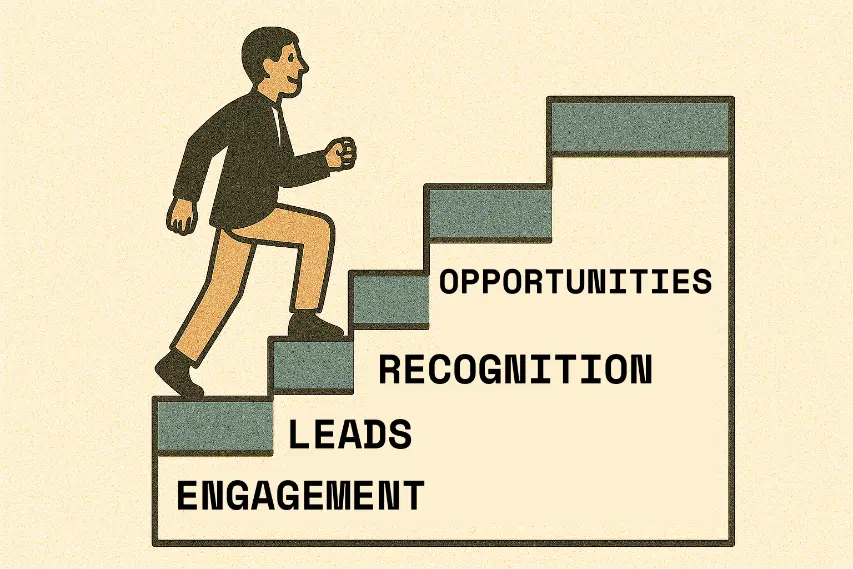
This is where having a systematic approach becomes crucial. Instead of trying to come up with content ideas from scratch every week, successful LinkedIn authority builders develop systems that make consistent posting sustainable.
The 60-Minute Authority Building Solution
The most successful professionals don't spend hours creating LinkedIn content. They spend 60 minutes once a month having strategic conversations about their expertise, and those conversations become the foundation for weeks of authority-building content.
The challenge isn't knowledge, it's extraction and presentation. You already have the expertise, the insights, the frameworks, the lessons learned, and the solutions to common problems in your field.
When you sit down for a guided conversation about your expertise, you naturally share insights, explain concepts, and provide solutions in a way that's authentic and valuable. No staring at blank pages, no writer's block, no wondering what to post about.
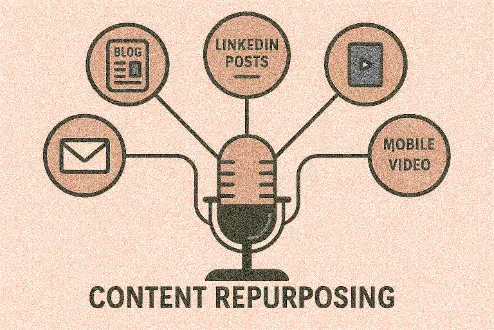
That 60-minute conversation can be transformed into:
- 4-6 video posts for LinkedIn
- 8-12 shorter clips for different platforms
- Blog content that supports your LinkedIn strategy
- Speaking presentation materials
- Email newsletter content
The key is having someone who knows how to ask the right questions to extract your most valuable insights and present them in a way that builds authority.
If you're tired of the content creation hamster wheel and want to explore how a strategic, guided approach could accelerate your LinkedIn authority building, it might be worth having a conversation about how Expert Insight Sessions could work for your specific expertise and goals.
The Algorithm Advantage: Why LinkedIn Rewards Expertise
LinkedIn's algorithm is specifically designed to surface expertise and professional insights.
Unlike other social platforms that prioritize entertainment or personal content, LinkedIn's algorithm looks for signals that indicate professional value:
- Comments that include industry-specific terminology
- Shares from people with relevant job titles
- Engagement from users who typically interact with professional content
- Time spent reading (which correlates with content depth and value)
When you consistently share expertise-based content, you're not fighting the algorithm, you're working with it.
The data backs this up: professional content on LinkedIn sees 2-3x higher reach than personal content, and posts that include industry insights get 40% more engagement than generic business content.
The Network Effect: How Authority Compounds
LinkedIn authority building compounds over time.
When you consistently share valuable insights in your field, three things happen:
- Peer Recognition: Other experts in your field start noticing and engaging with your content
- Algorithm Amplification: LinkedIn's algorithm begins showing your content to more people in your industry
- Opportunity Attraction: Decision-makers and opportunity creators start reaching out directly
This creates the "Authority Flywheel." Each piece of valuable content you share makes the next piece more likely to be seen and engaged with. Each new connection you make through your content expands your potential reach. Each opportunity that comes your way increases your credibility and authority.
Successful professionals don't just post content, they build systems for consistent expertise sharing that compound over time.
The Measurement Framework: Tracking Real Authority Building
Most professionals measure LinkedIn success wrong. They focus on vanity metrics like likes and comments instead of authority indicators.
Here's how to measure real LinkedIn authority building:
Immediate Indicators (0-3 months):
- Quality of comments (are people asking follow-up questions?)
- Profile views from relevant industry professionals
- Connection requests from potential clients or collaborators
- Direct messages about your content
Medium-term Indicators (3-9 months):
- Speaking invitation requests
- Media interview requests
- Collaboration opportunities with industry peers
- Inbound business inquiries
Long-term Indicators (9+ months):
- Industry recognition and awards
- Board or advisory position offers
- Premium pricing acceptance
- Thought leadership platform invitations
The goal isn't to become LinkedIn famous, it's to become the go-to expert in your field.
The Common Mistakes That Kill LinkedIn Authority
The most common mistakes that sabotage LinkedIn authority-building efforts:
Mistake #1: The Spray and Pray Approach: Posting about everything instead of focusing on specific areas of expertise. This confuses your audience and dilutes your authority.
Mistake #2: The Broadcasting Trap: Posting content without engaging in conversations. Authority is built through dialogue, not monologue.
Mistake #3: The Perfection Paralysis: Waiting for the "perfect" post instead of consistently sharing valuable insights. Consistency beats perfection every time.
Mistake #4: The Generic Content Curse: Sharing insights that could come from anyone instead of leveraging your unique experience and perspective.
Mistake #5: The Platform Confusion: Treating LinkedIn like other social media platforms instead of recognizing its unique professional context.
Mistake #6: The Impatience Problem: Expecting immediate results instead of understanding that authority building is a long-term strategy.
The Future of LinkedIn Authority Building
What's coming in the LinkedIn landscape:
Video Will Dominate Even More: With users already creating 2x more video content, and shorter videos (under 15 seconds) showing the highest engagement, professionals who master video-first authority building will have significant advantages.
AI Will Make Authenticity Premium: As AI-generated content becomes more prevalent, authentic expertise and personal insights will become even more valuable.
Niche Expertise Will Win: As the platform becomes more crowded, professionals who establish authority in specific niches will outperform generalists.
Community Building Will Matter: Professionals who build engaged communities around their expertise will see the highest returns.
The opportunity is massive, but the window for easy authority building is closing. Professionals who start building systematic, expertise-based LinkedIn strategies today will be the recognized authorities tomorrow.
Your Next Steps: From LinkedIn Lurker to Authority
Here's your action plan:
This Week:
- Complete your expertise audit (identify your 2-3 authority topics)
- Review your last 20 LinkedIn posts and identify the expertise gaps
- Plan your first expertise-based video post
This Month:
- Implement the Video-First Authority Strategy
- Start using the Conversation Catalyst approach
- Begin measuring authority indicators, not just engagement metrics
This Quarter:
- Develop a systematic approach to consistent expertise sharing
- Build relationships with other authorities in your field
- Track business outcomes from your LinkedIn authority-building efforts
You already have the expertise. You already know things that would be valuable to your industry peers and potential clients. The only question is whether you're going to share that expertise strategically or keep it to yourself.
The LinkedIn Authority Paradox is real: the platform with the highest engagement and the most decision-makers is being underutilized by the professionals who could benefit most from it.
The professionals who understand this and take action will build incredible authority. Those who don't will continue wondering why their LinkedIn presence isn't generating the opportunities they deserve.
Your industry is waiting for your insights. LinkedIn is ready to amplify them. The only thing missing is your commitment to showing up consistently as the expert you already are.
References
- Buffer - Engagement in 2025: Where Social Media Users Are Actually Interacting: https://buffer.com/resources/average-engagement-rate/
- Sprout Social - 28 LinkedIn Statistics That Marketers Must Know in 2025: https://sproutsocial.com/insights/linkedin-statistics/
- Engage AI - LinkedIn Statistics and Facts B2B Business Owners Should Know: https://engage-ai.co/linkedin-statistics-facts-b2b-business-owners-should-know-2024/
- Search Warrant - 6 Reasons LinkedIn is Great for B2B Marketing: https://www.searchwarrant.ca/linkedin-b2b-marketing/
- LinkedIn Business Solutions: https://business.linkedin.com/marketing-solutions

